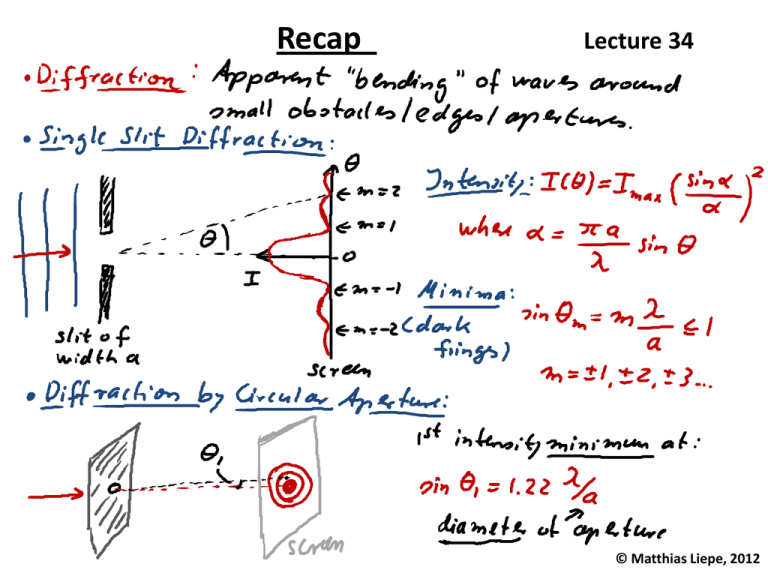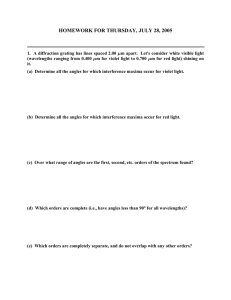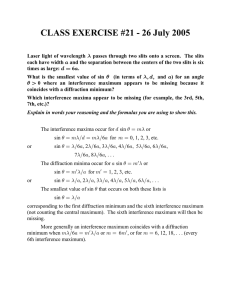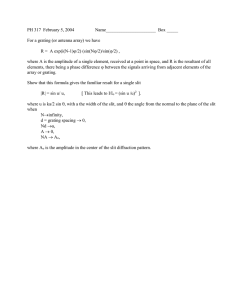N-slit interference
advertisement

Recap Lecture 34 © Matthias Liepe, 2012 Today: • Diffraction • Diffraction limited resolution • Double slit (again) • N slits • Diffraction gratings • Examples Pointillism • Technique of painting in which small, distinct dots of pure color are applied in patterns to form an image. • At normal viewing distance, the dots are irresolvable, and thus blend. Revisit: 2-slit Interference Look at the case where the screen is far away: D d & D . Nearly parallel rays d r is the path length difference. From before: Interference maxima where the path length difference is: r d sin( m ) m, m 0, 1, 2, . But, the slits have some finite width a! The intensities of these interference maxima are modulated by an ‘envelope’ single-slit diffraction function. N 2. 600 nm. d 9000 nm. a 2400 nm. 2-source interference: Maxima: sin(n) n/d, n 0, 1, 2, Minima: sin(n) (n ½)/d, n 0, 1, 2, 1 I( )/ I(0) λ/a=1/4 0.5 0 -30 0 30 (degrees) Here d is the spacing between slit centers. Actual patterns are the pink curves. Single-slit diffraction envelope: Minima: sin(m) m/a, m 0, m 1, 2, N 2. 600 nm. d 9000 nm. a 1200 nm. 1 I( )/ I(0) λ/a=1/2 0.5 Here a is the slit width. 0 -30 0 (degrees) 30 N-slit Interference d Principal maxima: occur where the path difference between rays from adjacent slits is an integer # of wavelengths. sin(n) n/d, n 0, 1, 2, Here d is the spacing between slit centers. N-slit Interference Interference minima: d Interference minima occur where sin(s) s/(Nd), s 0, s 1, 2, , except when s/N is an integer (position of principal maxima). Here d is the spacing between slit centers, and N is the number of slits. -> (N 1) minima between any two consecutive principal maxima. N-slit Interference d Subsidiary maxima: There are also (N 2) subsidiary maxima between any two consecutive principal maxima. These are much dimmer than the principal maxima. N-slit Interference Single-slit diffraction envelope: d Finally, if each slit has width a, then these interference patterns are modulated by a single-slit envelope function with minima at: sin(m) m/a, m 1, 2, m0 N-slit: Effect of increasing N N=6 N=30 N-slit: Effect of increasing slit width a λ/a=1/2 Actual patterns are the pink curves. λ/a=1/4 Single slit envelope functions are the blue curves. In the following equations, d represents center-to-center slit spacing, a represents slit width, λ represents the wavelength of normally incident plane waves, and N represents the # of slits. m 0, 1, 2, d sinm m d sinm m 21 m 0, 1, 2, a sin n n, n 1, 2, Nd sins s, s 1, 2, except when s/N is an integer Which of the above gives angles of intensity principal maxima? A. . B. . C. . D. . E. None of the above. In the following equations, d represents center-to-center slit spacing, a represents slit width, λ represents the wavelength of normally incident plane waves, and N represents the # of slits. m 0, 1, 2, d sinm m d sinm m 21 m 0, 1, 2, a sin n n, n 1, 2, Nd sins s, s 1, 2, except when s/N is an integer Which of the above gives angles of intensity subsidiary maxima? A. . B. . C. . D. . E. None of the above. In the following equations, d represents center-to-center slit spacing, a represents slit width, λ represents the wavelength of normally incident plane waves, and N represents the # of slits. m 0, 1, 2, d sinm m d sinm m 21 m 0, 1, 2, a sin n n, n 1, 2, Nd sins s, s 1, 2, except when s/N is an integer Which of the above give(s) angles of intensity minima? A. . B. . C. . D. . E. , , and . Diffraction gratings: Have a very large number N of equally spaced slits. Interference maxima are very narrow and occur where sin(n) n/d, n 0, 1, 2, , where d is the distance between slit centers. For a given value of n, different wavelengths will diffract at different angles and, because the maxima are very narrow, gratings can be used to analyze the wavelength composition of light. N=30 CD as Diffraction Grating: Interference • The tracks of a compact disc act as a diffraction grating • Nominal track separation on a CD is 1.6 micrometers, corresponding to about 625 tracks per millimeter. • This is in the range of ordinary laboratory diffraction gratings. • For red light of wavelength 600 nm, this would give a first order diffraction maximum at about 22° In the following equations, d represents center-to-center slit spacing, a represents slit width, λ represents the wavelength of normally incident plane waves, and N represents the # of slits. m 0, 1, 2, d sinm m d sinm m 21 m 0, 1, 2, a sin n n, n 1, 2, Nd sins s, s 1, 2, except when s/N is an integer Which of the above could be used to derive an expression for the angular width of a principal maximum of a diffraction grating? A. . B. . C. . D. . E. None of the above. Giant Blue Morpho • Some butterflies have the most striking iridescent blue wings, such as the blue morpho of South America • Blueness in butterflies is caused by optical interference. • The scales have multilayering that reflects light waves so that they travel different distance Iridescence • Iridescence is an optical phenomenon of surfaces in which hue changes in correspondence with the angle from which a surface is viewed • Caused by multiple reflections from two or more surfaces in which phase shift and interference of the reflections modulates the incidental light. X-ray (Bragg) Diffraction: • X rays are EM waves whose wavelengths are 1 Å 1010 m. -> atomic diameters. • In a crystalline solid the regular array of atoms forms a 3dimensional “diffraction grating” for x rays. X-ray (Bragg) Diffraction (cont.): • If an x-ray beam is sent into a crystal it is scattered (redirected) by the crystal structure. • In some directions scattered waves undergo destructive interference resulting in intensity minima. • In other directions scattered waves undergo constructive interference resulting in intensity maxima. • This scattering process is complicated but intensity maxima turn out to occur in directions as if the incoming x rays were reflected by a family of parallel reflecting planes that extend through the atoms within the crystal & that contain regular arrays of the atoms. X-ray (Bragg) Diffraction: Bragg Diffraction • Diffraction from a three dimensional periodic structure such as atoms in a crystal is called Bragg diffraction. • Each dot in this diffraction pattern forms from the constructive interference of X-rays passing through a crystal. • The data can be used to determine the crystal's atomic structure. X-Ray Diffraction at Cornell: CESR/CHESS High-energy X-ray diffraction was used to pinpoint some 5 million atoms in the protective protein coat used by hundreds of viruses. Credit: J. Pan & Y.J. Tao




